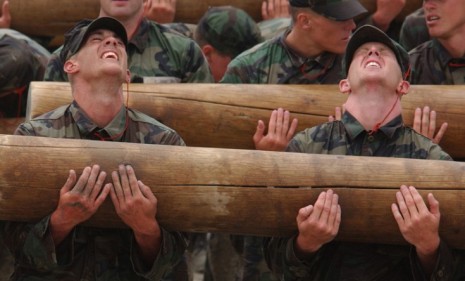Inside the mind of a Navy SEAL
In The Wall Street Journal, Navy SEAL Eric Greitens gives a firsthand account of the torturous training and gripping camaraderie of the elite force

The elite, super-secret team of Navy SEALs that killed Osama bin Laden on May 1 are still largely shrouded in mystery. But in The Wall Street Journal, Eric Greitens, a SEAL in the U.S. Navy reserve and the author of The Heart and the Fist: The Education of a Humanitarian, the Making of a Navy SEAL, offers an insider's insight on what it takes to become a SEAL, and what their lives are like. "Most of the men on that mission had dedicated the past decade of their lives to this fight," he says. "They — and their families — had made great personal sacrifices." Here, an excerpt:
The rigors that SEALs go through begin on the day they walk into Basic Underwater Demolition/SEAL training in Coronado, Calif., universally recognized as the hardest military training in the world. BUD/S lasts a grueling six months. The classes include large contingents of high-school and college track and football stars, national-champion swimmers, and top-ranked wrestlers and boxers, but only 10% to 20% of the men who begin BUD/S usually manage to finish. About 250 graduate from training every year. ...
The pinnacle of SEAL training is known as Hell Week, a period of continuous tests and drills during which most classes sleep only a total of two to five hours. ...
The Week
Escape your echo chamber. Get the facts behind the news, plus analysis from multiple perspectives.

Sign up for The Week's Free Newsletters
From our morning news briefing to a weekly Good News Newsletter, get the best of The Week delivered directly to your inbox.
From our morning news briefing to a weekly Good News Newsletter, get the best of The Week delivered directly to your inbox.
Almost all the men who survived possessed one common quality. Even in great pain, faced with the test of their lives, they had the ability to step outside of their own pain, put aside their own fear and ask: How can I help the guy next to me? They had more than the "fist" of courage and physical strength. They also had a heart large enough to think about others, to dedicate themselves to a higher purpose.
Read the entire article in The Wall Street Journal.
A free daily email with the biggest news stories of the day – and the best features from TheWeek.com
-
 A running list of the US government figures Donald Trump has pardoned
A running list of the US government figures Donald Trump has pardonedin depth Clearing the slate for his favorite elected officials
-
 Ski town strikers fight rising cost of living
Ski town strikers fight rising cost of livingThe Explainer Telluride is the latest ski resort experiencing an instructor strike
-
 ‘Space is one of the few areas of bipartisan agreement in Washington’
‘Space is one of the few areas of bipartisan agreement in Washington’Instant Opinion Opinion, comment and editorials of the day